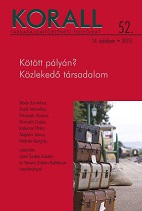A közlekedés szerepe a városi térhasználatban Szombathelyen (1945–1968)
The Role of Transport in the Urban Space of Szombathely between 1945 and 1968
Author(s): Péter KalocsaiSubject(s): History
Published by: KORALL Társadalomtörténeti Egyesület
Summary/Abstract: Transport is one of the most determinant aspects of the use of space. In spite of this, the history of urban transport seems to have held little interest for historians. Hungarian and international literature suggests that little work has been done to explore the relationship between transport and urban development. Works in this field concentrate rather on interurban transport (railway, waterways, air travel) than intraurban transport (local transport within a settlement). In the socialist era, the transport in Szombathely, a Hungarian mid-sized town was characterised by lack of funds to expand and develop the transport infrastructure inherited from pre-war years. Decisions regarding the town’s transport issues were not made locally and the town was at the mercy of central will. The town’s transport was characterised by the prevalence of foot and bicycle traffic, as well as public transport. The relatively small size of the town was especially favourable for foot and bicycle traffic. The development of transport, especially public transport, failed to keep up with geographical expansion and population growth of the town, as well as its industrial development which began to attract commuters. As tramways were bursting at the seams, the town’s bus network was beginning to develop. The public transport grid was established by the 1960s, which facilitated and accelerated the use of urban space. However, the quality of service was significantly lower than pre-war standards: overcrowded vehicles, skipping services, and so on, were all common signs of substandard service. The quality of services were hardly consistent with the town’s transport needs and the population’s effective demand. This may have been one of the reasons for the predominance of foot and bicycle traffic in comparison with public transport. Private companies in public transport were eliminated. Buses, lorries and taxis were merged into the state-owned AKÖV company, while trams were transferred under the management of the town council. Politics had a marked influence on transport, including free transport for privileged individuals, the use of communist symbols (red star, red flag), and changing street names. Minor changes can be seen after 1958, when private cars were allowed on the roads, larger capacity tram carriages were introduced, and the number of bus lines was increased. Private cars continued to play little or no role in the use of the town’s urban spaces.
Journal: Korall - Társadalomtörténeti folyóirat
- Issue Year: 2013
- Issue No: 52
- Page Range: 113-144
- Page Count: 32
- Language: Hungarian

